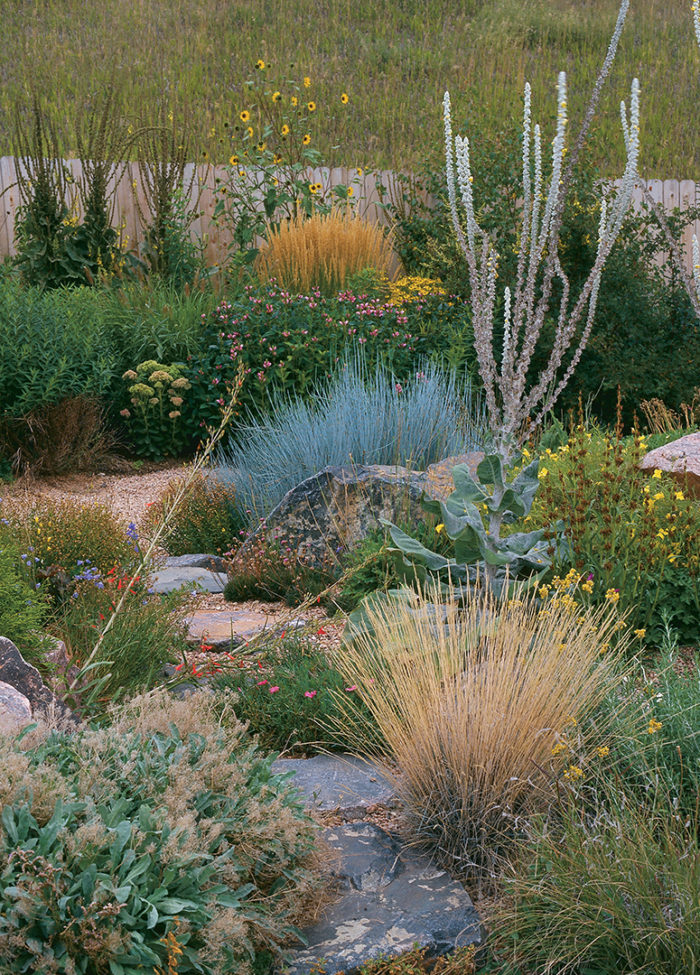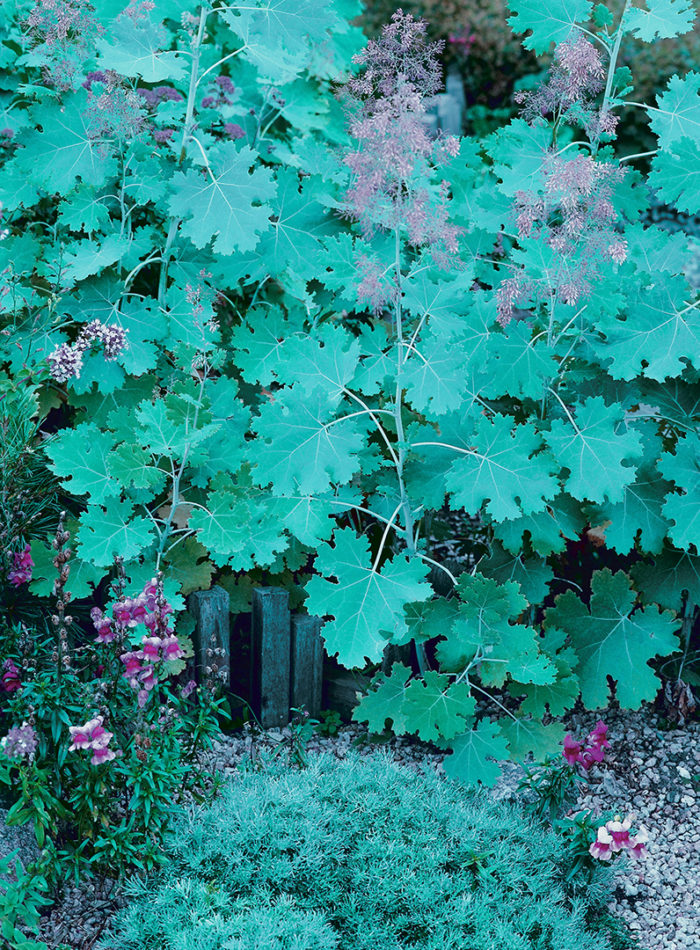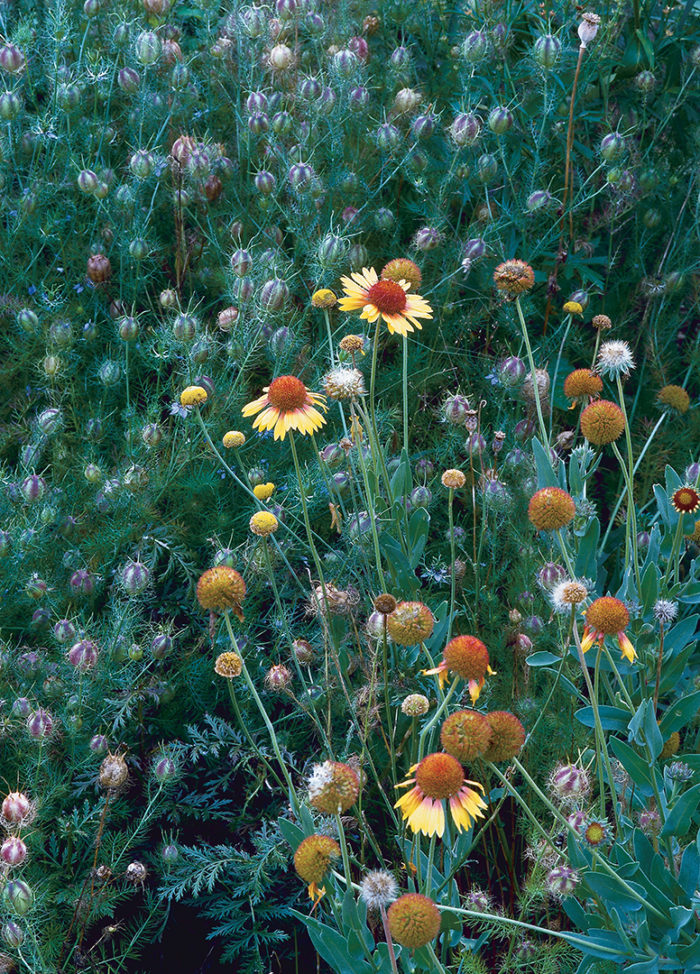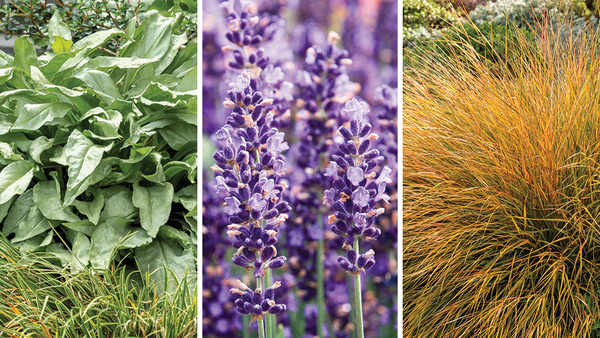
I yearn for a garden whose beauty lasts all year, a garden filled with eye-appealing combinations that lure me from one spot to the next. I’ve searched far and wide for ways to bring this special magic to my garden, and I’ve looked in some unusual places. Some of my ideas are drawn from psychology and alchemy, the sciences of change and transformation. Alchemy, dating from the Middle Ages, was an early form of chemistry. Its practitioners invoked mystical and natural powers in an effort to change lead and other base metals into gold. By combining two or more simple, raw materials, medieval alchemists sought to create an entirely different element, an alloy more enchanting and exciting than the sum of its parts.
That’s what I try to do in my garden with plants and other materials. Alchemy is a wonderful metaphor for gardening. By mixing and contrasting diverse plants and their parts—including leaves, stems, and seed heads—I can refashion a lovely garden picture and, hopefully, create a new composition that’s worth its weight in gold.
Opposites are attractive

I like plants with dynamic visual appeal: dramatic foliage, beautiful silky flowers, spiky seed heads. A plant with any one of these qualities is lovely by itself. But over the years, I’ve learned the real beauty of a garden lies in its combinations, and that a single lovely plant becomes an even more dramatic player when placed near another plant or object that is in some way its visual opposite. Placing something rough next to something smooth, something large next to something small, or even something round next to something linear, creates a dramatic juxtaposition. Now I even use parts of the hardscape to enhance my textural garden compositions. Boulders, unusual pots, and gravel paths all play roles in the visually rich textures at the heart of my garden.
One of my favorite ways to create visual texture is to combine plants in ways that emphasize and dramatize their differences. Putting a towering plant with large foliage, like plume poppy (Macleaya cordata), next to something that snuggles against the ground with very tiny leaves, like pussytoes (Antennaria parvifolia ‘McClintock’), for example, dramatizes their differences and creates a spirited pairing.
The principle of pairing opposites also holds true for any grouping of plants based on radically different features, whether it is size, shape, or habit. This can be especially effective with ornamental grasses. I placed the upright plumes of feather reed grass (Calamagrostis acutiflora ‘Karl Foerster’) next to a billowy clump of hairy brome (Bromus ramosus). Although both grasses are about the same shade of tan late in the season, their strikingly different silhouettes—one drooping and one staunchly vertical—make a pleasing pairing. A cluster of prickly-looking, blue orbs of flat sea holly (Eryngium planum) next to the grasses adds another textural element to the composition.
Varying plant height also contributes to dynamic garden compositions. In my garden, I’ve emphasized contrasts in size by placing clusters of small, detail-rich plants against a background panorama of tall plants with bold, textural features.
Use all parts of a plant, from stems to seed heads

My garden reinvents itself as spring, summer, and fall progress, creating vibrant snapshots of plants in different phases of their seasonal cycles. At one time of year, a plant’s contribution to the garden picture may be its fuzzy leaves or thorny stems, at another, it may be soft, delicate flowers. Later still, it may be prickly seed heads.
Love-in-a-mist (Nigella damascena) is the perfect example of a plant that’s constantly evolving to create new compositions. With ferny foliage, frilly-looking flowers, and, later in the season, spiky, swollen seedpods, its ever-changing features can play all sorts of roles. Using it with blanket flower (Gaillardia spp.) creates an interesting effect. Though they are both round, the cool, prickly-looking love-in-a-mist seedpods and the warm, sensuous blanket flower blossoms are strikingly different. The contrasts between the two invite inspection.
Grasses add great interest and form to the garden, and can be contrasted with other plants in large or small scale. But I find them just as useful for their delicate seed heads. The seed heads of most grasses are an airy, feathery finale to the growing season and bring a sense of fragility to pairings with more sturdy, architectural foliage. The airy, wandlike seed heads of sheep’s fescue (Festuca ovina) offer dramatic contrast against the more intricate leaves of a bloody cranesbill (Geranium sanguineum) and fast-spreading cypress spurge (Euphorbia cyparissias).
Put the hardscape to work too
My garden’s hardscape—gravel paths, smooth ceramic containers, and rugged-looking boulders—also plays a role in creating visual textures. Just as with plants, the key is combining the visual “feel” of these inorganic elements—their hardness, smoothness, or coarse texture—with something that looks dramatically different.
In one spot of the garden, I placed a smooth, twine-draped, clay vessel next to a gravel path, where the roughness of the tiny stones plays against the sleek look of the pot. To add even richer textures, I planted the area with borage (Borago officinalis), whose fuzzy foliage brings softness to the composition. Even the colors work—the blue of the borage, the burnt orange of the pot, and the tawny hues of the gravel create a solidly earthy palette. I see the union of these many opposites as an electrifying alchemical event. Each element draws on the other, making this a splendid garden moment.
I even use the boulders which crop up here and there in my garden to help link my plantings visually. They add a sense of the ageless, and their solidity provides a resting place for the eye against the bustle of foliage and flower that enriches so much of the garden. To me, the stones and the tufts of grass I plant near them tie my garden into a cohesive whole by creating a recurring, textural theme.
The stones play another, more cerebral role for me. I garden near Denver, Colorado, and the boulders have a rugged, inorganic character that makes the overlay of living plants seem even more magical. It’s almost like a microcosm of my Rocky Mountain surroundings.
Practice the fine art of restraint

As much as I like the play of opposites in my garden, I’m careful to avoid introducing too much contrast and busyness. That only creates confusion and a visual mess. Instead, I work to create something with more subtlety, and look for a gentle alliance between hardscape and plants, something that looks more like a graceful dance than a wild fling. Finding that balance can be hard, but I’ve learned to trust my eye, my feelings, and my hunches. After all, I’m the one it’s got to please most.
I’ve made plenty of mistakes over the years, but I don’t lose sleep over them. If I create something that is over the top, I just undo it. Plants and small objects can always be moved, and even the best gardens can be enhanced and improved. Making a good garden better is part of the fun of gardening.
I enjoy watching and working in my garden as it grows and evolves from season to season. And I enjoy the eternal dance of its elements, the pairing of its opposites, and the alchemical magic that transforms it to something that, to me, has the luster of gold.





















Comments
Log in or create an account to post a comment.
Sign up Log in